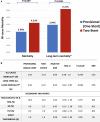Single- Versus 2-Stent Strategies for Coronary Bifurcation Lesions: A Systematic Review and Meta-Analysis of Randomized Trials With Long-Term Follow-up
- PMID: 29802145
- PMCID: PMC6015365
- DOI: 10.1161/JAHA.118.008730
Single- Versus 2-Stent Strategies for Coronary Bifurcation Lesions: A Systematic Review and Meta-Analysis of Randomized Trials With Long-Term Follow-up
Abstract
Background: The majority of coronary bifurcation lesions are treated with a provisional single-stent strategy rather than an up-front 2-stent strategy. This approach is supported by multiple randomized controlled clinical trials with short- to medium-term follow-up; however, long-term follow-up data is evolving from many data sets.
Methods and results: Meta-analysis of randomized controlled trials evaluating long-term outcomes (≥1 year) according to treatment strategy for coronary bifurcation lesions. Nine randomized controlled trials with 3265 patients reported long-term clinical outcomes at mean weighted follow-up of 3.1±1.8 years. Provisional single stenting was associated with lower all-cause mortality (2.94% versus 4.23%; risk ratio: 0.69; 95% confidence interval, 0.48-1.00; P=0.049; I2=0). There was no difference in major adverse cardiac events (15.8% versus 15.4%; P=0.79), myocardial infarction (4.8% versus 5.5%; P=0.51), target lesion revascularization (9.3% versus 7.6%; P=0.19), or stent thrombosis (1.8% versus 1.6%; P=0.28) between the groups. Prespecified sensitivity analysis of long-term mortality at a mean of 4.7 years of follow-up showed that the provisional single-stent strategy was associated with reduced all-cause mortality (3.9% versus 6.2%; risk ratio: 0.63; 95% confidence interval, 0.42-0.97; P=0.036; I2=0).
Conclusions: Coronary bifurcation percutaneous coronary intervention using a provisional single-stent strategy is associated with a reduction in all-cause mortality at long-term follow-up.
Keywords: bifurcation; bifurcation intervention; bifurcation lesion; provisional stenting.
© 2018 The Authors. Published on behalf of the American Heart Association, Inc., by Wiley.
Figures





References
-
- Louvard Y, Thomas M, Dzavik V, Hildick‐Smith D, Galassi AR, Pan M, Burzotta F, Zelizko M, Dudek D, Ludman P, Sheiban I, Lassen JF, Darremont O, Kastrati A, Ludwig J, Iakovou I, Brunel P, Lansky A, Meerkin D, Legrand V, Medina A, Lefevre T. Classification of coronary artery bifurcation lesions and treatments: time for a consensus!. Catheter Cardiovasc Interv. 2008;71:175–183. - PubMed
-
- Palmerini T, Sangiorgi D, Marzocchi A, Tamburino C, Sheiban I, Margheri M, Vecchi G, Sangiorgi G, Ruffini M, Bartorelli AL, Briguori C, Vignali L, Di Pede F, Ramondo A, Inglese L, De Carlo M, Bolognese L, Benassi A, Palmieri C, Filippone V, Barlocco F, Lauria G, De Servi S. Ostial and midshaft lesions vs. bifurcation lesions in 1111 patients with unprotected left main coronary artery stenosis treated with drug‐eluting stents: results of the survey from the Italian Society of Invasive Cardiology. Eur Heart J. 2009;30:2087–2094. - PubMed
-
- Brar SS, Gray WA, Dangas G, Leon MB, Aharonian VJ, Brar SK, Moses JW. Bifurcation stenting with drug‐eluting stents: a systematic review and meta‐analysis of randomised trials. EuroIntervention. 2009;5:475–484. - PubMed
-
- Chen SL, Santoso T, Zhang JJ, Ye F, Xu YW, Fu Q, Kan J, Zhang FF, Zhou Y, Xie DJ, Kwan TW. Clinical Outcome of Double Kissing Crush Versus Provisional Stenting of Coronary Artery Bifurcation Lesions: The 5‐Year Follow‐Up Results From a Randomized and Multicenter DKCRUSH‐II Study (Randomized Study on Double Kissing Crush Technique Versus Provisional Stenting Technique for Coronary Artery Bifurcation Lesions). Circ Cardiovasc Interv. 2017;10:e004497. - PMC - PubMed
-
- Chen SL, Zhang JJ, Han Y, Kan J, Chen L, Qiu C, Jiang T, Tao L, Zeng H, Li L, Xia Y, Gao C, Santoso T, Paiboon C, Wang Y, Kwan TW, Ye F, Tian N, Liu Z, Lin S, Lu C, Wen S, Hong L, Zhang Q, Sheiban I, Xu Y, Wang L, Rab TS, Li Z, Cheng G, Cui L, Leon MB, Stone GW. Double kissing crush versus provisional stenting for left main distal bifurcation lesions: DKCRUSH‐V randomized trial. J Am Coll Cardiol. 2017;70:2605–2617. - PubMed
Publication types
MeSH terms
Grants and funding
LinkOut - more resources
Full Text Sources
Other Literature Sources
Medical

